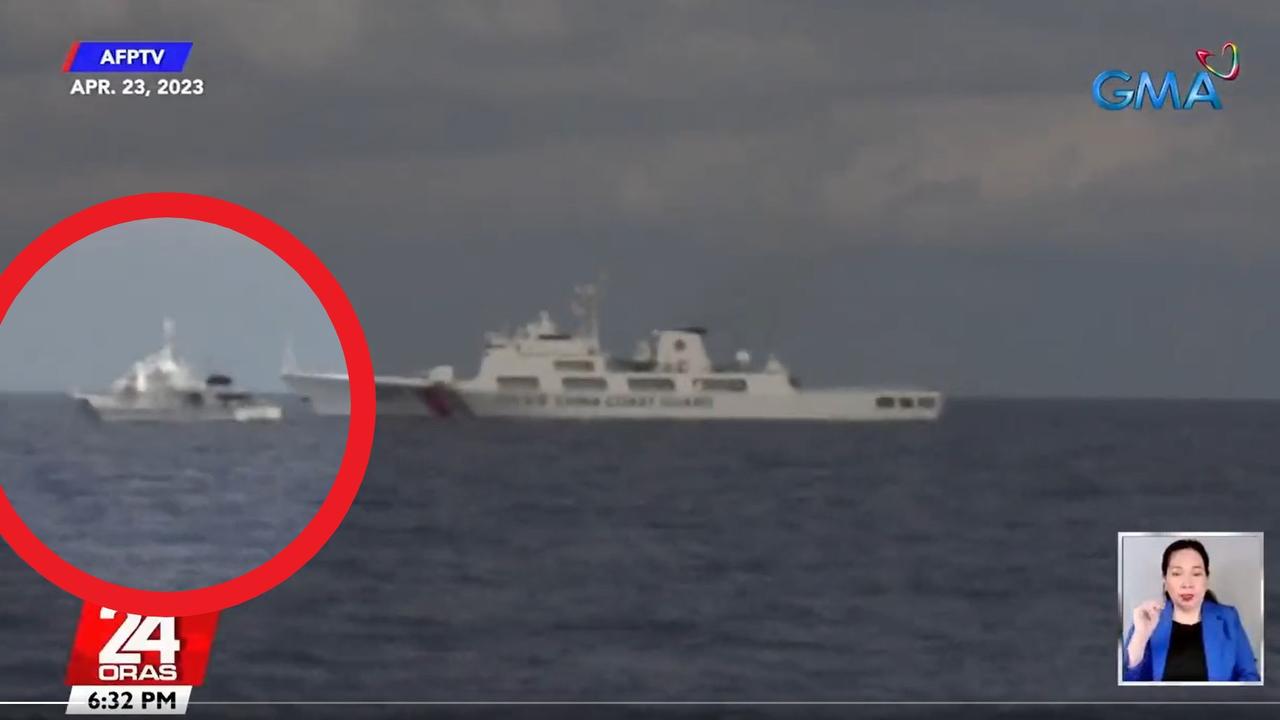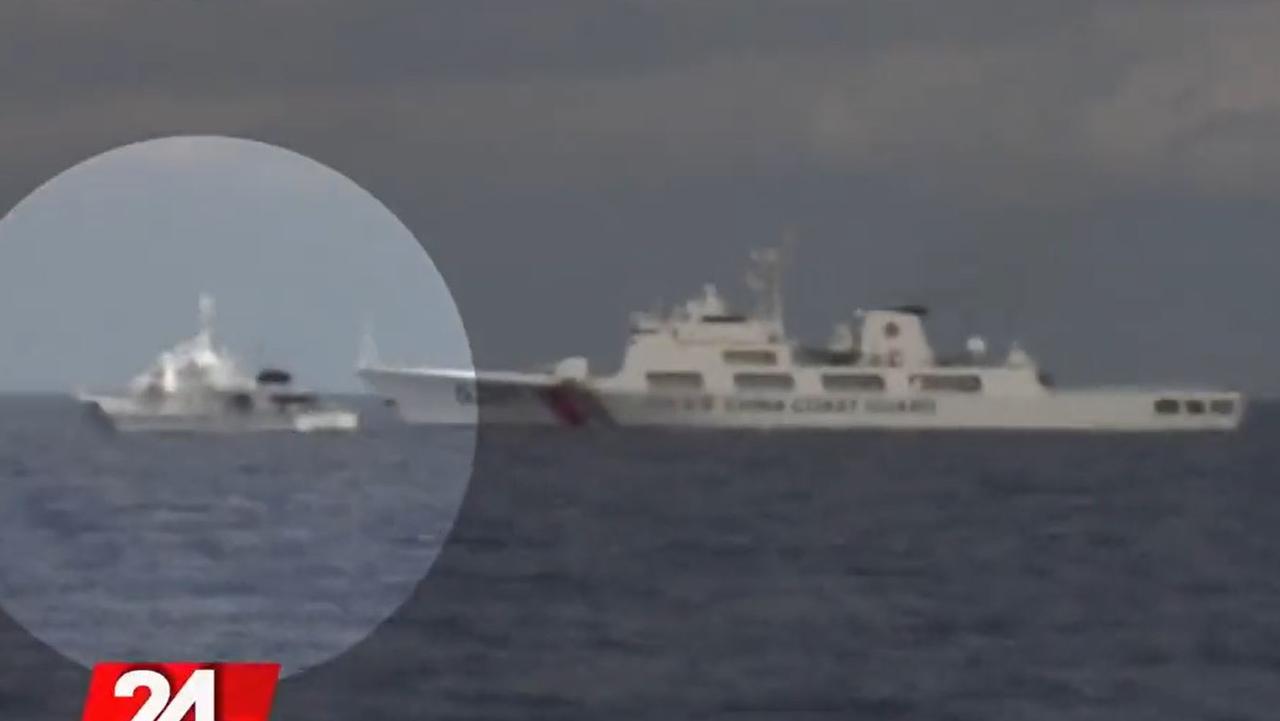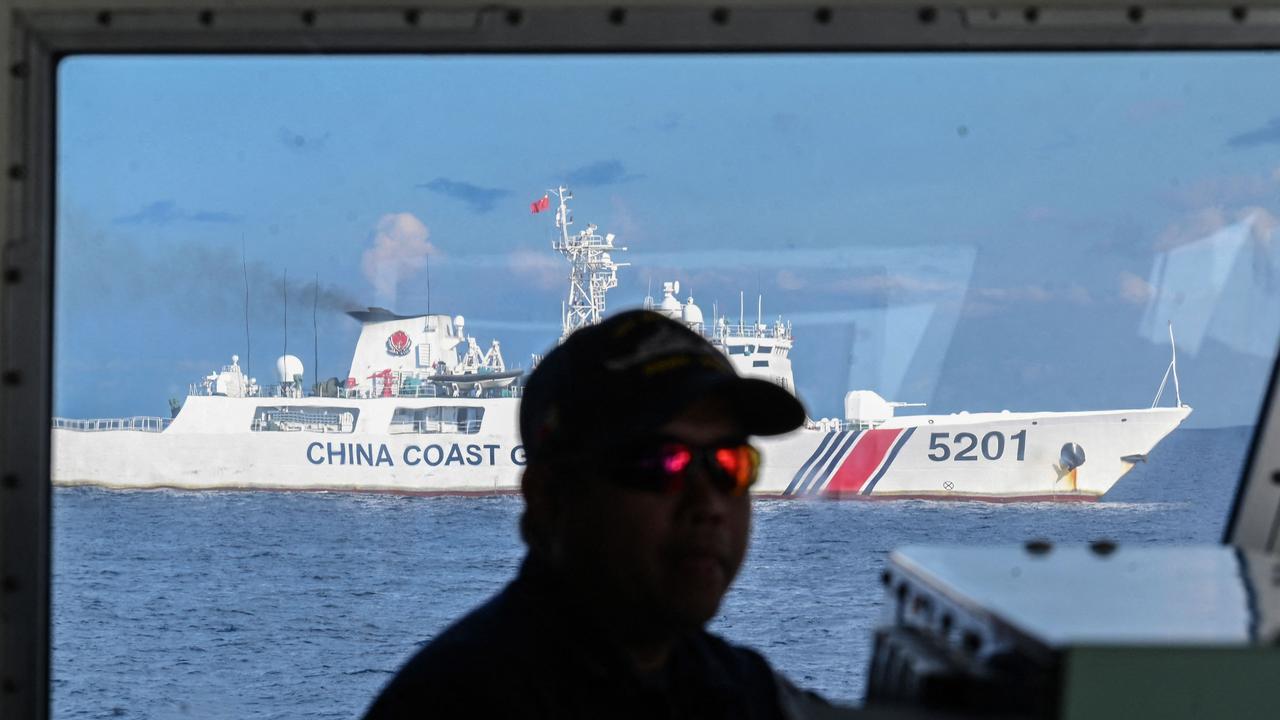‘Underdog’ country takes on China as tensions flare in South China Sea
China has one billion more people than this tiny island country, but a South China Sea near-miss has caused a stand-off.

The Philippines is making a “David versus Goliath” stand in the South China Sea, and it hopes its courage against overwhelming odds will reign in China’s growing aggression.
This new tactic is already having the desired effect.
Washington has demanded Beijing stop “harassment and intimidation” of Philippine fishing and coast guard vessels in the Spratly Islands and Scarborough Shoal. Australia, the UK and Canada have also expressed concern through their ambassadors to Manila over China’s “dangerous conduct” in disputed waters.
The international criticism comes after a dangerous standoff between opposing coast guard vessels was caught on video. Media teams were “embedded” aboard coast guard vessels and aircraft in a deliberate move by Manila to show the world what was really happening within its Exclusive Economic Zone (EEZ).

More than 100 Chinese “militia” vessels, a warship, and two coast guard cutters have been observed operating in Philippine territory in recent weeks.
In response, Manila deployed two 52m-long coast guard cutters to enforce its territorial rights around Second Thomas Shoal, around 200km off the home island of Palawan.
But a large Chinese coast guard cutter deliberately forced one of the small Philippine vessels to take emergency evasive action just days after a Chinese navy corvette, the People’s Liberation Army Navy (PLAN) Changzhou, challenged the Philippine cutters patrolling near Pag-asa (Thitu) Island.
“The publication of China’s blatant disregard of international law and harassment of lowly Filipino fishermen dismisses Beijing’s claim that it supports peace and stability in the region,” Philippine Coast Guard Commodore Jay Tristan Tarriela argues in an essay published by The Diplomat. “This approach is a way to hold China accountable for its actions and send a message that the Philippines will not back down in the face of Chinese aggression.”
It’s also earning Manila international recognition.
Australian Ambassador to the Philippines Hae Kyong Yu joined an increasingly vocal global community when he decried, “further reports of unprofessional and dangerous conduct against the Philippines”. He reiterated Australia’s “call for peace, stability and respect for UNCLOS (United Nations Convention on the Law of the Sea) in the South China Sea, a vital international waterway.”
Line in the sand
Two Chinese coast guard vessels intercepted Philippine patrol boats on April 23 as they approached the shoal. One, the 103m-long CCG 5201, crossed within 45m of the much smaller Philippine coast guard vessel BRP Malapascua.
“This close proximity posed a significant threat to the safety and security of the Philippine vessel and its crew,” Commodore Tarriela said.
Vietnam also claims the shoal. But the Philippine Navy deliberately grounded an old World War II-era assault ship there in 1999 as a semipermanent military outpost.
In recent years, China’s coast guard has actively attempted to prevent supplies from being delivered to the marines stationed there – including by using water cannons.
“This is the kind of thing that we’re hoping to avoid,” Philippines President Bongbong Marcos Jr said. “This time, it was a little more dangerous because they were close. [Such acts] can cause casualties on both sides.”
Muntik nang magbangaan ang mga barko ng Pilipinas at China matapos harangin ng mga Tsino ang PCG na nagpa-patrolya sa West Philippine Sea.
— GMA Integrated News (@gmanews) April 28, 2023
Bagay na kung hindi naagapan, ay maaaring nakapagpahamak sa mga sakay ng barko, ayon sa ating coast guard. | Apr. 28, 2023 pic.twitter.com/KRW6HmKtBg
Beijing, however, accuses the Philippines of being the aggressor.
Chinese Foreign Ministry spokeswoman Mao Ning said the Philippine coast guard vessels had “trespassed” by approaching Second Thomas Shoal, and it was they who had “dangerously approached” a Chinese vessel.
“The Chinese Coast Guard vessel upheld China’s territorial sovereignty and maritime order by making timely manoeuvres to dodge the dangerously approaching Philippine vessel and avoid a collision,” she said. “The Chinese side’s manoeuvres were professional and restrained.”
Washington, however, takes a different view.
This video released by the PCG shows its close encounter with the Chinese coast guard in the vicinity of Ayungin Shoal last Apr. 23.
— Inquirer (@inquirerdotnet) April 28, 2023
“This close proximity posed a significant threat to the safety and security of the Philippine vessel and its crew,†PCG says. | @FMangosingINQpic.twitter.com/63n3bEIJLC
“The United States stands with our Philippine allies in upholding the rules-based international maritime order,” US State Department spokesman Matthew Miller said in a statement at the weekend.
“Imagery and video recently published in the media is a stark reminder of PRC harassment and intimidation of Philippine vessels as they undertake routine patrols within their exclusive economic zone.”
Mr Miller blamed Beijing for “provocative and unsafe conduct” and emphasised Washington’s commitment to the 1951 US Philippines Mutual Defence Treaty could be triggered by any attack on Philippine civilian or military vessels or aircraft.
“The United States continues to track and monitor these interactions closely,” he said.
Round-table talks
Dr Collin Koh of Singapore’s Institute of Defence and Strategic Studies wrote in the latest edition of the United States Navy Institute (USNI) Proceedings magazine that the West “should tap into and bolster this ‘David vs. Goliath’ spirit and courage”.
“Even though China possesses the advantage in terms of physical force, South-East Asian co-disputants are not meekly conceding ground. While they are hamstrung by capacity shortfalls, several claimants actively are pushing back against Chinese maritime coercion,” he said.
Such a disparity in strength gives Manila an “underdog” status on the world stage.
“We thank the United States and Australia for their unwavering support,” Commodore Tarriela said. “We remain optimistic that other states that recognise the importance of upholding international law and adhering to a rules-based order will follow suit and express their support.”
LOOK: The @coastguardph joins the Inaugural Civil Maritime Security Study Exchange in Australia!
— Philippine Coast Guard (@coastguardph) May 2, 2023
It served as an opportunity for meaningful dialogue with counterparts from the @AusBorderForce, DFAT, DoD, and AFMA, on civil maritime security and regional cooperation. 🫡🇵ðŸ‡ðŸ‡¦ðŸ‡º pic.twitter.com/79dePBpKZO
Such pressure is having an effect.
Beijing has this week agreed to “sit down” and discuss “fishing rights” in the disputed region. But it continues to assert complete “sovereignty” over almost 90 per cent of the South China Sea, despite being surrounded by many other nations, including Vietnam, Malaysia, Brunei and Indonesia.
Philippine President Mr Marcos said he has ordered his coast guard and the Department of Foreign Affairs to draw up a detailed map outlining his nation’s rights as confirmed under a Permanent Court of Arbitration ruling made at The Hague on July 2016.
This will be presented to Beijing.
— Jay L Batongbacal (@JayBatongbacal) April 29, 2023
The President said he would also push for a “direct communication line” with China to discuss any differences of opinion and de-escalate tensions.
“The overall priority is to safeguard our maritime territory,” he said.
Mr Marcos flew to Washington for talks with US President Joe Biden earlier this week.
Ahead of the talks, Mr Marcos said he would not allow his country to become a military “staging post” for the US in a conflict over Taiwan.
Manila recently moved to restore its military ties with Washington, granting it access to additional military bases.
“We will not encourage any provocative action that will involve the Philippines by any other country,” Mr Marcos said.
Meanwhile, Mr Biden has reaffirmed what he called “iron-clad alliance commitments” while discussing the transfer of modern patrol craft to the Philippines’ armed forces.
Two Cyclone-class coastal patrol vessels are already en route to Manila. Additional assets will include two Protector-class patrol boats and three C-130H Hercules aircraft.
Growing anger
Beijing is upset the Philippines Coast Guard had media on board.
Ms Mao accused Manila of “premeditated provocation” to “deliberately create a friction, and be blamed on China and hyped up in the media”.
“China strongly protests and deplores this,” she said.

“[Beijing] urged the Philippines to respect China’s territorial sovereignty and maritime rights and interests in the South China Sea; while at the same time stop actions that could further complicate the situation.”
It’s the reaction Manila was expecting.
“In exposing PRC aggression, the Philippines aims to, devoid of any exaggeration or ill-intent, provide a truthful account of the situation in the West Philippine Sea,” Commodore Tarriela tweeted shortly after the incident. “The goal is to illustrate Beijing’s blatant disregard for international law and the resulting risk and dangers to the lives of PCG personnel simply doing their job.”
The routine, seven-day maritime patrol carried out by the @coastguardph in the WPS from April 18-24 was non-provocative and did not undermine the interests of other states. The PCG is under no obligation to request permission from other nations while patrolling the waters near… https://t.co/lwsbBr2Q6m
— Jay Tarriela (@jaytaryela) April 29, 2023
In his essay, the Commodore said the previous policy of keeping such incidents quiet to appease Beijing had backfired.
“Fake news flooded social media platforms, creating a distorted narrative,” he wrote. “This misinformation led many to believe that China was a “good friend” and a “partner for peace and development”.
But an incident in February where Beijing denied one of its ships shined a military-grade laser at a Philippine vessel – despite photos and footage clearly showing it doing so – brought about a change in tack.
“The factual accounts, accompanied by striking images and unsettling videos, proved to be a powerful tool in reshaping public opinion and debunking false narratives,” he said.
Jamie Seidel is a freelance writer | @JamieSeidel






